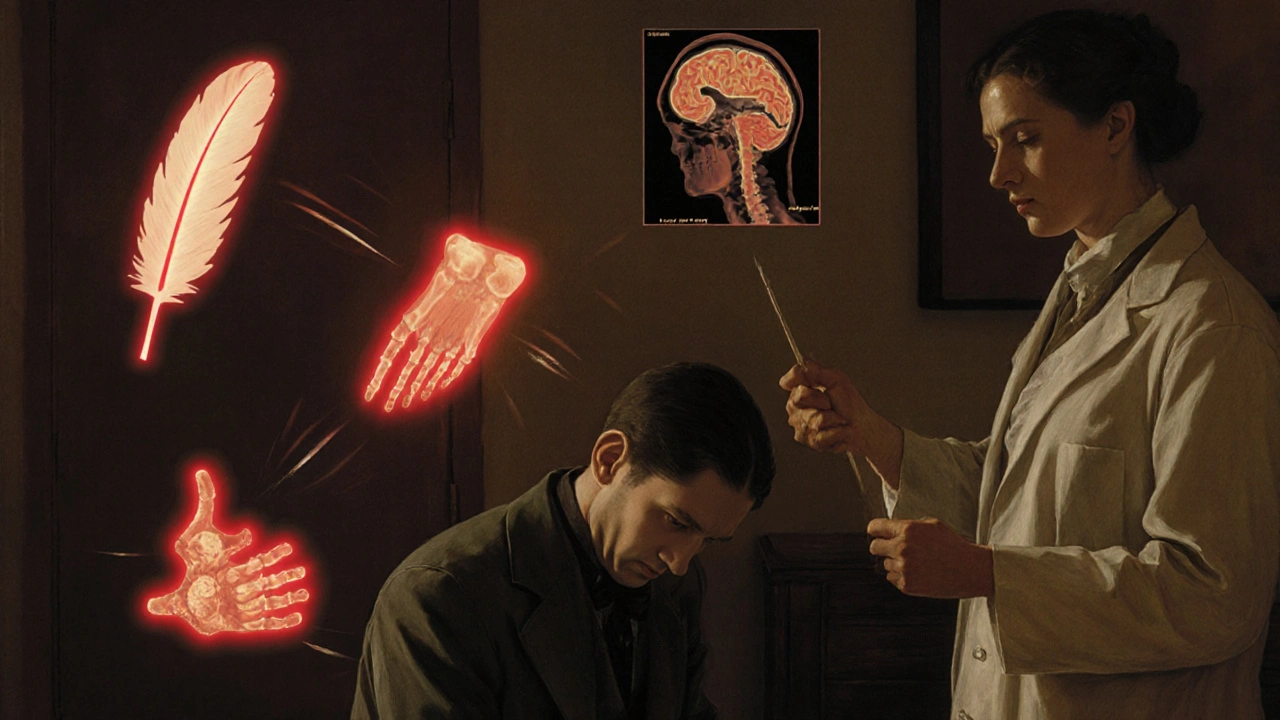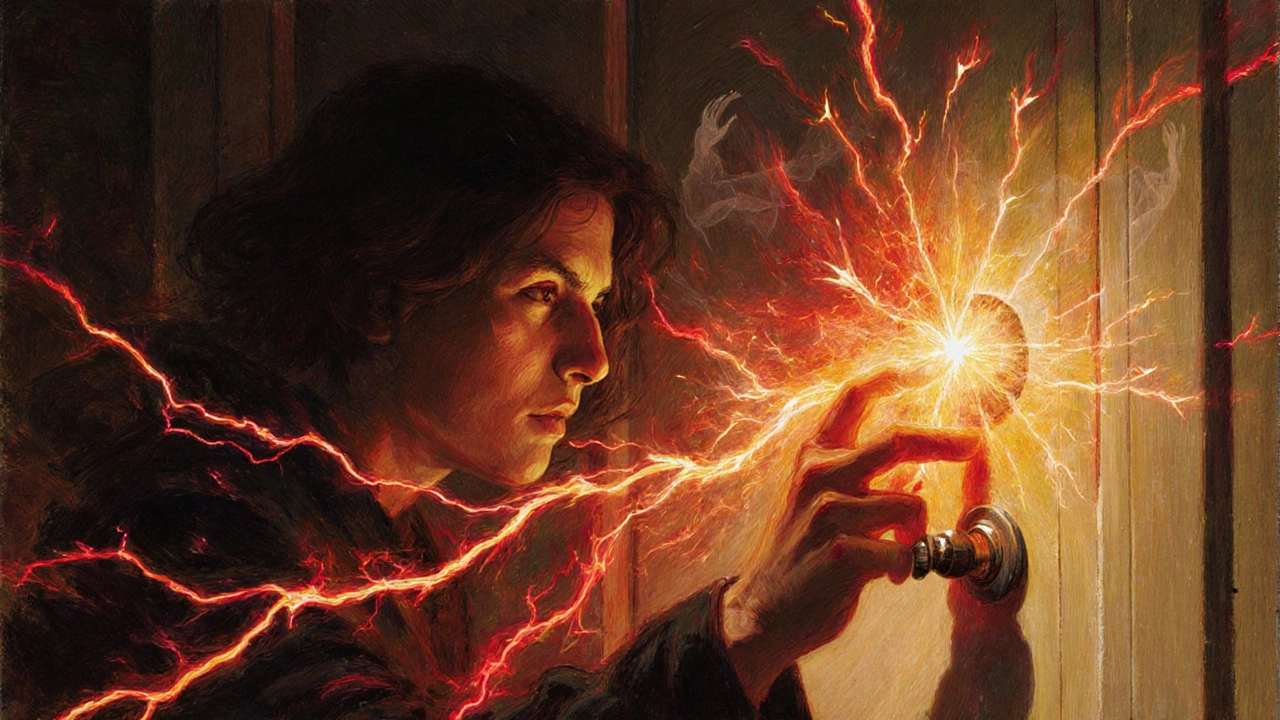Imagine touching a doorknob and feeling like your skin is on fire. Or having a light hug feel like needles piercing your body. If you’ve ever been told your pain is ‘all in your head’-but you know it’s real-then you might be experiencing central sensitization. This isn’t imagination. It’s your nervous system turning up the volume on pain signals, even when there’s no injury left to heal.
What Exactly Is Central Sensitization?
Central sensitization happens when your brain and spinal cord become hypersensitive to pain. Think of it like a stereo stuck on max volume. Even quiet sounds feel loud. In this case, normal touches, slight movements, or even stress can trigger intense pain. It’s not that something’s broken in your muscles or joints-it’s that your nervous system is misfiring. This wasn’t always understood. Back in 1983, neuroscientist Clifford J. Woolf first described it as the spinal cord’s ‘wind-up’ phenomenon. He noticed that repeated pain signals could rewire the central nervous system, making it more reactive. Today, we know this isn’t just a theory. Brain scans show that people with central sensitization have 20-35% more activity in pain-processing areas of the brain. Their spinal cord neurons are more excitable. Their natural pain-blocking systems are weakened. It’s why someone with fibromyalgia can feel pain all over-even though blood tests and X-rays show nothing wrong. It’s why chronic low back pain can persist for years after a herniated disc has healed. The damage is gone, but the pain signal keeps running.How Do You Know If You Have It?
There’s no single blood test for central sensitization. But doctors use patterns to spot it. Here’s what to look for:- Widespread pain-affecting multiple areas of the body, not just one spot.
- Allodynia-pain from things that shouldn’t hurt, like clothing, light pressure, or a breeze.
- Hyperalgesia-an extreme reaction to pain that should be mild, like a pinch feeling like a burn.
- Temporal summation-pain builds up over time with repeated stimuli. Tap your arm ten times? It starts to hurt more with each tap.
- Pain that outlasts healing-pain lasting longer than 3-6 months after an injury, even when tissue has repaired.
What Causes It?
Central sensitization doesn’t happen overnight. It’s built over time. Common triggers include:- Repeated injuries or chronic inflammation
- Post-viral syndromes (like long COVID or Epstein-Barr flare-ups)
- Surgery with persistent pain
- Emotional trauma or prolonged stress
- Autoimmune conditions like lupus or rheumatoid arthritis

It’s Not ‘All in Your Head’-Here’s Why
One of the most painful parts of living with central sensitization is being dismissed. Too many patients hear, ‘It’s psychological,’ or ‘You’re just stressed.’ But this isn’t a mental health issue-it’s a neurological one. The American Academy of Family Physicians (AAFP) makes this clear: central sensitization is a real, measurable change in how the central nervous system processes pain. It’s not depression. It’s not anxiety. Those can make it worse, but they don’t cause it. Think of it like tinnitus. You hear ringing in your ears, but there’s no external sound. The problem isn’t your ears-it’s your brain misinterpreting signals. Central sensitization works the same way. The pain is real because the nervous system has changed.Conditions Linked to Central Sensitization
This mechanism isn’t rare. It’s behind many chronic pain conditions:- Fibromyalgia-90% of patients show clear signs of central sensitization.
- Chronic low back pain-35-45% of cases that last beyond 3 months involve central sensitization.
- Migraines and chronic headaches-brainstem and cortical hyperexcitability mirror central sensitization patterns.
- Interstitial cystitis and irritable bowel syndrome-both show heightened sensitivity to internal stimuli.
- Post-surgical pain syndromes-15-30% of people develop persistent pain after surgery, even with no nerve damage.
How Is It Treated?
Treating central sensitization isn’t about fixing a broken part. It’s about retraining the nervous system. Medications help-but they’re just one piece. Medications:- Pregabalin (Lyrica) and gabapentin reduce nerve overactivity. About 52% of patients report significant relief at doses of 150-300mg daily.
- Duloxetine (Cymbalta), an SNRI, helps restore natural pain inhibition. Around 45% see 30% pain reduction.
- Low-dose naltrexone (LDN) at 4.5mg nightly reduces inflammation and resets immune signaling. About 40% of fibromyalgia patients respond.
- Nortriptyline (25-50mg nightly) helps with sleep and pain modulation.
- Pain neuroscience education-learning how your nervous system works reduces fear and catastrophizing. Studies show 20-30% drop in pain-related anxiety after just a few sessions.
- Graded exercise-slow, steady movement rebuilds tolerance. Starting at 10% weekly increases helps avoid flare-ups.
- Mindfulness and meditation-reduces pain interference scores by 25% after 8 weeks.
- Cognitive behavioral therapy (CBT)-helps reframe thoughts about pain, reducing emotional amplification.







Written by Martha Elena
I'm a pharmaceutical research writer focused on drug safety and pharmacology. I support formulary and pharmacovigilance teams with literature reviews and real‑world evidence analyses. In my off-hours, I write evidence-based articles on medication use, disease management, and dietary supplements. My goal is to turn complex research into clear, practical insights for everyday readers.
All posts: Martha Elena